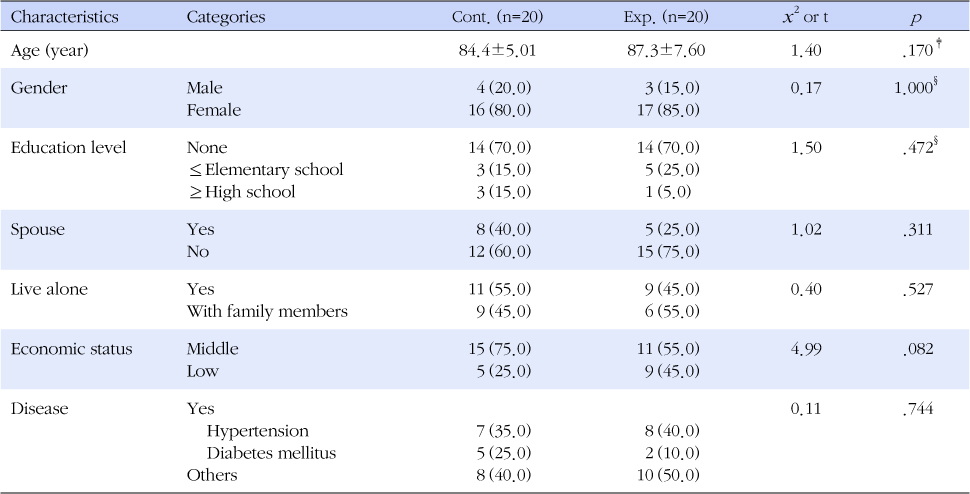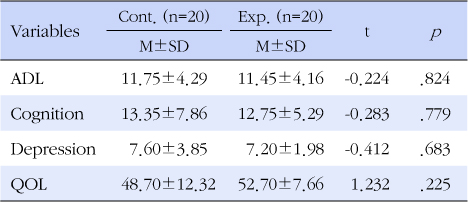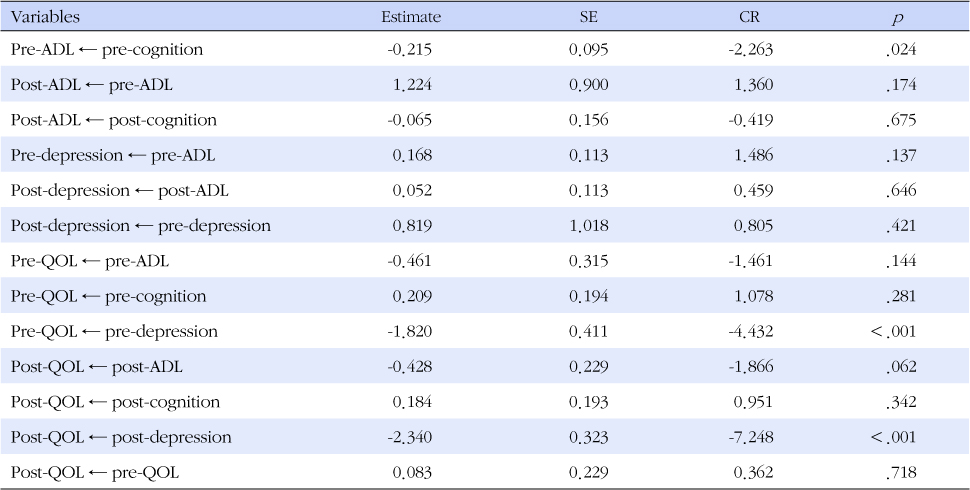References
1. Bastone Ade C, Filho WJ. Effect of an exercise program on functional performance of institutionalized elderly. J Rehabil Res Dev 2004;41(5):659–668.
2. Cho SH, Kim SJ. The effects 12 weeks of combined exercise programs on activities of daily living and quality of living index in the vascular dementia elders. J Korean Soc Phys Med 2010;5(4):633–644.
3. Choi YJ, Hwang HH, Kim BR. The effects of dance therapy program on the cognitive function and memory of movement of elderly with dementia. Korean J Phys Educ 2010;49(1):373–382.
4. Eun Y, Woo SH, Kim ES, Kim HS. The effects of calligraphy and exercise program on Korean elders' self-esteem, stress, quality of life and physical health. J Korean Acad Community Health Nurs 2008;19(1):76–87.
5. Hopman-Rock M, Staats PG, Tak EC, Dröes RM. The effects of a psychomotor activation programme for use in groups of cognitively impaired people in home for the elderly. Int J Geriatr Psychiatry 1999;14(8):633–642.
6. Jang NS. Effect of regular rhythm exercise program on change of activity fitness and life satisfaction in the elderly women. Korean J Growth Dev 2008;16(3):215–223.
7. Jang YR, Chiriboga DA, Kim GY. Acculturation and manifestation of depressive symptoms among Korean American older adults. Korean J Res Gerontol 2006;15:51–73.
8. Jeon EY, Kim SY, Yoo HS. Effects of music therapy and rhythmic exercise on quality of life, blood pressure and upper extremity muscle strength in institution-dwelling elderly women. J Korean Acad Nurs 2009;39(6):829–839.
http://dx.doi.org/10.4040/jkan.2009.39.6.829.
9. Jung YM, Kim JH. Comparison of cognitive levels, nutritional status, depression in the elderly according to living situations. J Korean Acad Nurs 2004;34(3):495–503.
10. Kim BK, Rhim YT, Park IS. Effect of regular aerobic exercise on the prevention of cognitive decline and brain disease in elderly people. J Korean Soc Study Phys Educ 2013;18(2):217–229.
11. Kim NI. The effect of Danjeon breathing and walking exercise on activities of daily living, life stress and depression in the elderly women. Korean J Growth Dev 2011;19(3):215–223.
12. Kim NJ. Effects of group exercise program on the cognitive function, activities of daily living and depression in the elderly with dementia Yongin: Yong-in University; 2008. Unpublished master's thesis.
13. Kim SH. The development of gymnastic program for the CVA elderly. J Sport Leis Stud 2005;25:503–515.
15. Kim YG, Han DW, Lee BK. The effects of walking and Yoga exercise on the cognitive function in the elderly women. J Korean Soc Phys Med 2010;5(2):211–221.
17. Lautenschlager NT, Cox KL, Flicker L, Foster JK, van Bockxmeer FM, Xiao J, et al. Effect of physical activity on cognitive function in older adults at risk for Alzheimer disease: A randomized trial. JAMA 2008;300(9):1027–1037.
18. Lee HS, Kim CM, Paik SB. Effects of group intervention program on depression and quality of life in Korean elderly with chronic disease. Korean J Health Promot 2011;11(4):217–226.
19. Lee HS, Kim DK, Ko HJ, Ku HM, Kwoon EJ, Kim JH. The standardization of geriatric quality of life scale. Korean J Clin Psychol 2003;22(4):859–881.
20. Lim JO, Yu JB, Kwon JY, Byun HG, Huh JS, Cho WJ. Development of sugar sensitive drosophila cell based ISFET sensor for Alzheimer's disease diagnosis. J Korean Sensor Soc 2013;22(4):281–285.
http://dx.doi.org/10.5369/JSST.2013.22.4.281.
21. Moon SB. Basic concepts and applications of structural equation modeling Seoul: Hakjisa; 2009.
23. Park HK, Kim JS, Lee JB, Seo WS, Koo BH, Bai DS. Manifestation of cognitive function in geriatric patient with subjective memory complaint. Yeungnam Univ J Med 2010;27(1):27–36.
24. Park JH, Kwon YC. Modification of the mini-mental state examination for use in the elderly in a non-western society. Part I. development of Korean version of minimental state examination. Int J Geriatr Psychiatry 1990;5:381–387.
25. Park WY, Kim KH, Song SH, Ko SS. The effect of 12 week exercise leading on basal fitness and quality of life development in agriculture old adult. J Korean Soc Study Phys Educ 2011;15(4):215–226.
26. Park YI, Lee KY, Kim TI, Kim DO, Kim JH. The effects of exercise in the frail elderly. J Korean Acad Community Health Nurs 2012;23(1):91–101.
27. Shin MK. Effects of an exercise program on frontal lobe cognitive function in elders. J Korean Acad Nurs 2009;39(1):107–115.
28. Son HH. The effects of exercise program on activities of daily living and balance in elderly with dementia Daegu: Daegu University; 2007. Unpublished master's thesis.
29. Studer M. Cognitive rehabilitation in the frail elderly patient: Never too old to learn? Top Geriatr Rehabil 2004;20(1):21–33.
30. Um SY, Kwak YS, Kim SS. The effects of regular exercise on cognitive function & exercise capacity in patient with senile dementia. Korean J Phys Educ 2004;43(3):691–697.





